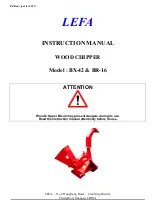
Service/maintenance
Chapter 7
OPERATION MANUAL
V2.3.0en/07.06.19//17.12
Unichiller®
77
PROCEDURE
Press the
>Emergency stop switch<
[70].
All poles of the temperature control unit are disconnected
immediately
.
Restart the temperature control unit in normal mode after a successful function test. Please see
page 46, section
»Turning on the temperature control unit«
.
7.4
Thermal fluid inspection, replacement and circuit cleaning
The illustration “connection diagram” can be found on page 85 in section
.
Extremely hot / cold surfaces, connections and thermal fluids
BURNS/FREEZING OF LIMBS
Surfaces, connections and tempered thermal fluids can be extremely hot or cold depending on
the operating mode.
Avoid direct contact with surfaces, connections and thermal fluids!
Wear your personnel protective equipment (e.g. temperature-resistant safety gloves, safety
goggles).
During an active circulation, the thermal fluid circuit is shut off by shut-off valves
MATERIAL DAMAGE TO THE CIRCULATING PUMPS INSTALLED IN THE TEMPERATURE CONTROL
UNIT
Do not close the thermal fluid circuit during an active circulation by means of shut-off valves.
Warm the thermal fluid to room temperature before stopping the circulation.
7.4.1
Thermal fluid inspection
Thermal fluid is not inspected on a regular basis
BURNS DUE TO REDUCED BOILING POINT
Regularly check your thermal fluid whether it meets the specifications in the safety data sheet.
Thermal fluid is not inspected on a regular basis
DAMAGE TO THE HEAT EXCHANGER AND/OR ELECTROMECHANICAL PARTS.
Regularly check your thermal fluid whether it meets the specifications in the safety data sheet.
Oxidation
Oxidation ages the thermal fluid and changes its characteristics (e.g. reduces its boiling point).
When controlling high temperatures, a reduced boiling point may cause overflow of very hot
thermal fluids at the
>Expansion vessel<
[18]. It may cause serious burns of the limbs.
Hygroscopy
When continuously thermoregulating below room temperature, hygroscopy causes the thermal
fluid to accumulate water in the course of time. Such a liquid mixture causes the evaporator to
burst when thermoregulating in the minus range. This is caused by the water in the liquid mixture,
which forms ice crystals on the evaporator. When thermoregulating high temperatures with such a
liquid mixture, the boiling point is reduced. When controlling high temperatures, a reduced boiling
point may cause overflow of very hot thermal fluids at the
>Expansion vessel<
[18]. It may cause
serious burns of the limbs.
Hygroscopy can change the mixing ratio of a water-ethylene-glycol mixture.
7.4.2
Thermal fluid replacement
Mixing different thermofluids in a thermal fluid circuit
PROPERTY DAMAGE
Do
not
mix different types of thermofluid (such as mineral oil, silicone oil, synthetic oil, water,
etc.) in a thermofluid circuit.
The thermal fluid circuit
must
be rinsed when changing from one type of thermal fluid to an-
other. No residues of the previous type of thermal fluid may remain in the thermal fluid circuit.
Содержание Unichiller 400T
Страница 1: ...Unichiller...
Страница 2: ......
Страница 3: ...OPERATION MANUAL Unichiller...
Страница 4: ......
Страница 6: ...OPERATION MANUAL Unichiller V2 3 0en 07 06 19 17 12 6 Pilot ONE Layout of the Home screen...
Страница 85: ...Annex Chapter 9 OPERATION MANUAL V2 3 0en 07 06 19 17 12 Unichiller 85 9 Annex...










































